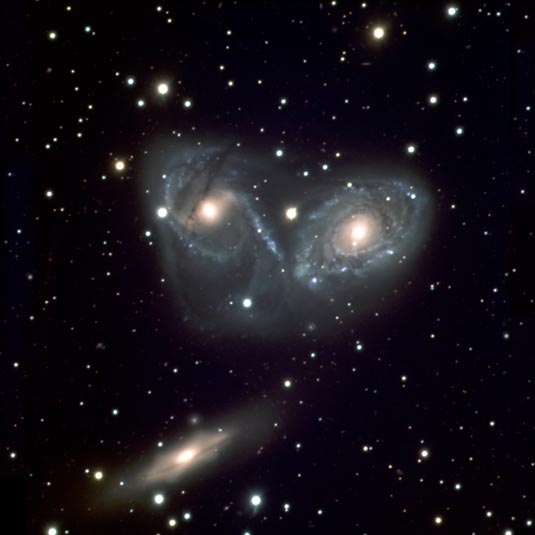
Galaxy Triplet NGC 6769-71
Interacting galaxies
RA 19h 18m 22.7s Dec -60° 30' 3.54"
Pavo
200 million light years
6.47 x 6.47 arcminutes
North is 0.3° right of vertical
ESO
April 28, 2004
ABOUT THIS IMAGE:
Stars like our Sun are members of galaxies, and most galaxies are themselves members of clusters of galaxies. In these, they move around among each other in a mostly slow and graceful ballet. But every now and then, two or more of the members may get too close for comfort - the movements become hectic, sometimes indeed dramatic, as when galaxies end up colliding.
This image shows an example of such a cosmic tango. This is the superb triple system NGC 6769-71, located in the southern constellation of Pavo (the Peacock) at a distance of 190 million light-years.
This
composite image was obtained on April 1, 2004, the day of the Fifth Anniversary
of ESO's Very Large Telescope (VLT). It was taken in the imaging mode
of the VIsible Multi-Object Spectrograph (VIMOS) on Melipal, one of the
four 8.2-m Unit Telescopes of the VLT at the Paranal Observatory (Chile).
The two upper galaxies, NGC 6769 (upper right) and NGC 6770 (upper left),
are of equal brightness and size, while NGC 6771 (below) is about half
as bright and slightly smaller. All three galaxies possess a central bulge
of similar brightness. They consist of elderly, reddish stars and that
of NGC 6771 is remarkable for its "boxy" shape, a rare occurrence
among galaxies.
NGC
6769 is a spiral galaxy with very tightly wound spiral arms, while NGC
6770 has two major spiral arms, one of which is rather straight and points
towards the outer disc of NGC 6769. NGC 6770 is also peculiar in that
it presents two comparatively straight dark lanes and a fainter arc that
curves towards the third galaxy, NGC 6771 (below). It is also obvious
from this new VLT photo that stars and gas have been stripped off NGC
6769 and NGC 6770, starting to form a common envelope around them, in
the shape of a Devil's Mask. There is also a weak hint of a tenuous bridge
between NGC 6769 and NGC 6771. All of these features testify to strong
gravitational interaction between the three galaxies. The warped appearance
of the dust lane in NGC 6771 might also be interpreted as more evidence
of interactions. Moreover, NGC 6769 and NGC 6770 are receding from us
at a similar velocity of about 3800 km/s - a redshift just over 0.01 -
while that of NGC 6771 is slightly larger, 4200 km/s.
As dramatic and destructive as this may seem, such an event is also an enrichment, a true baby-star boom. A cosmic catastrophe like this one normally results in the formation of many new stars. This is obvious from the blueish nature of the spiral arms in NGC 6769 and NGC 6770 and the presence of many sites of star forming regions.
Similarly, the spiral arms of the well-known Whirlpool galaxy (Messier 51) may have been produced by a close encounter with a second galaxy that is now located at the end of one of the spiral arms; the same may be true for the beautiful southern galaxy NGC 1232 depicted in another VLT photo (ESO Press Photo eso9845).
Nearer to us, a stream of hydrogen gas, similar to the one seen in the image, connects our Galaxy with the LMC, a relict of dramatic events in the history of our home Galaxy. And the Andromeda Galaxy, another of the Milky Way neighbors in the Local Group of Galaxies, is approaching us. Still at a distance of over 2 million light-years, calculations predict that it will collide with our galaxy in about 6,000 million years!
Technical information: ESO Press Photo eso0413 is a photo-composite showing the triplet of galaxies NGC 6769, 6770 and NGC 6771, as observed with the VIMOS instrument on Melipal, one of the four 8.2-m Unit Telescopes of ESO's Very Large Telescope. The images were obtained on the morning of April 1, 2004 during twilight in three different wavebands, each of which is here being represented by a different color: Blue channel (U) around 380 nm, Green channel (B) at 425 nm and the Red channel (V) at 550 nm. The total exposure time in the U, B and V bands is, respectively, 20, 6 and 12 minutes. The mean seeing was around 0.9 arcsec.